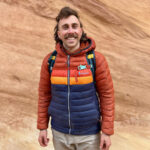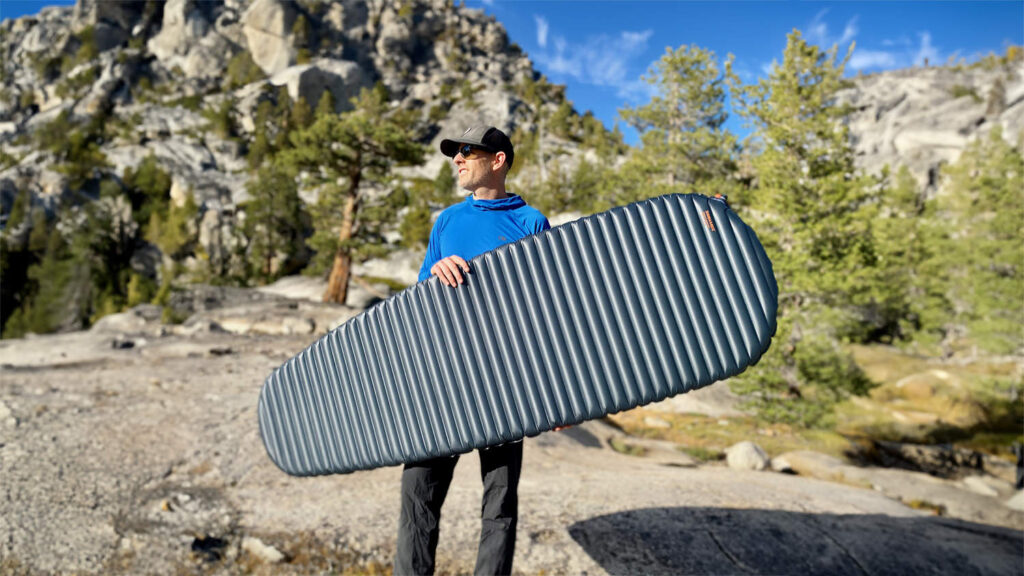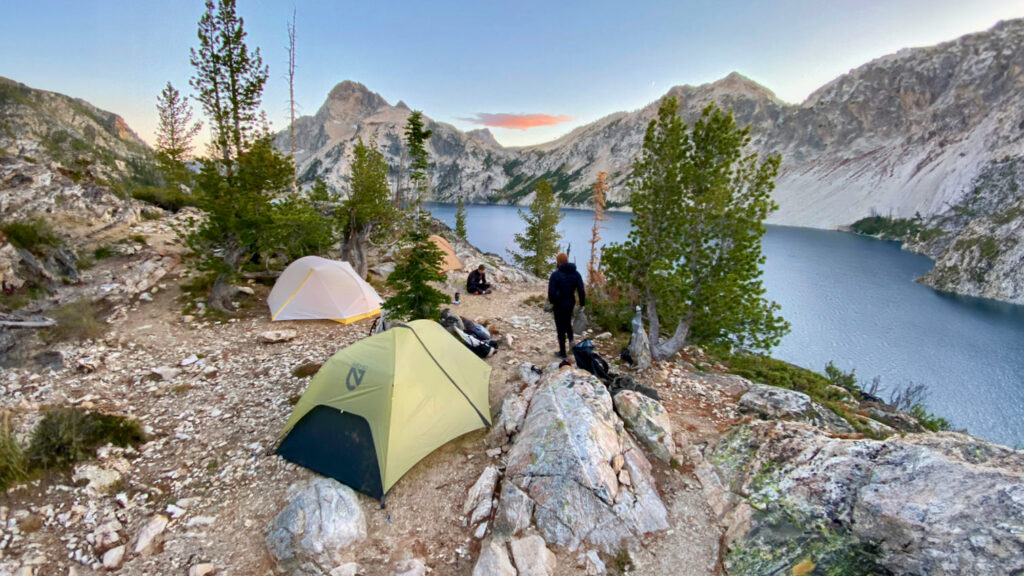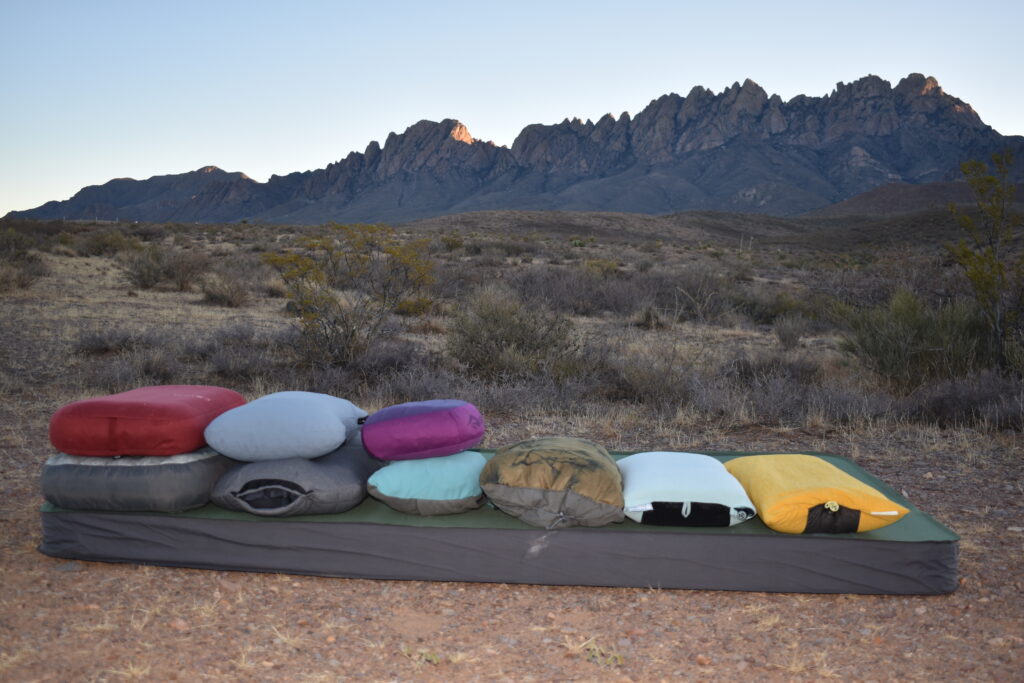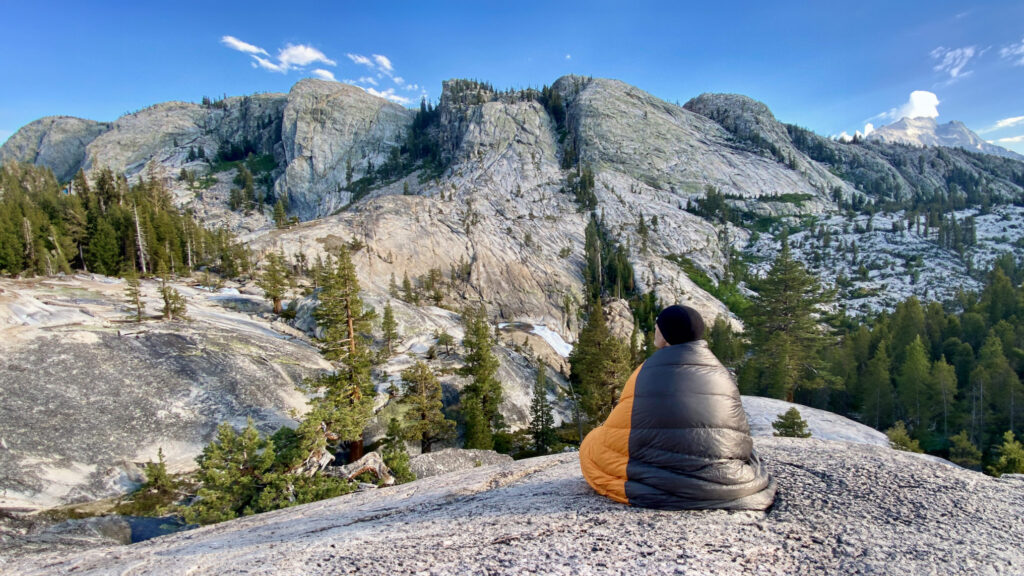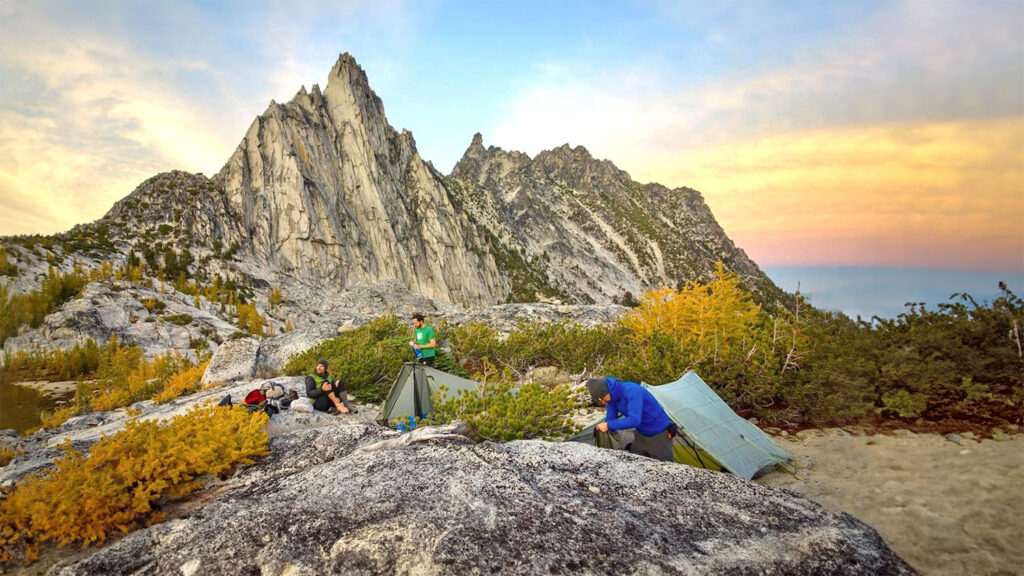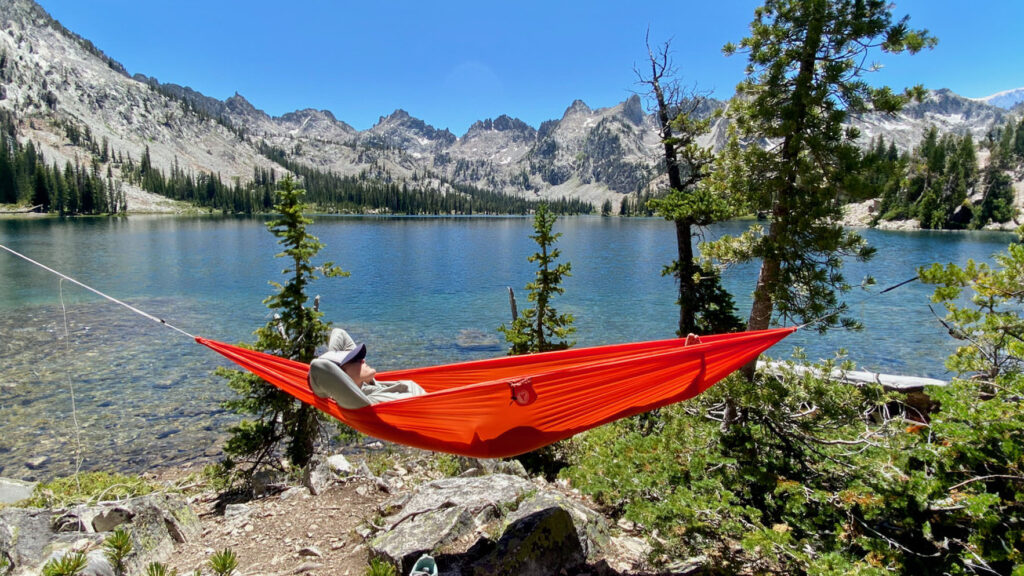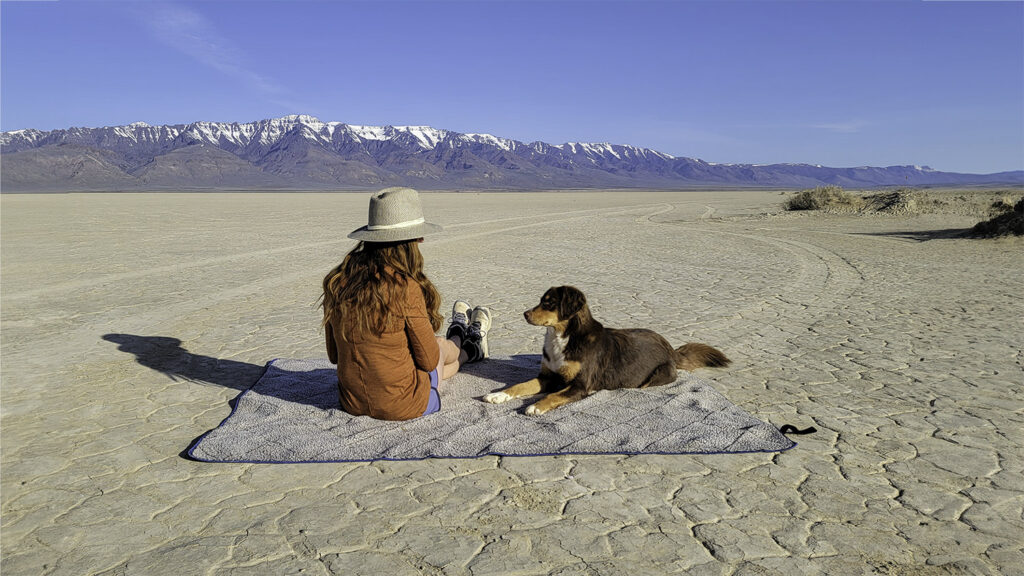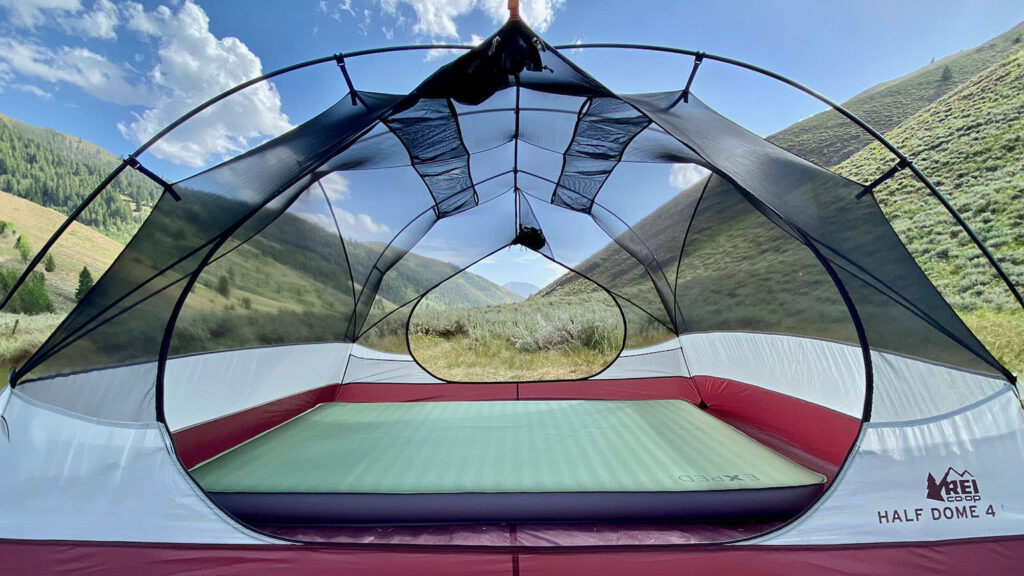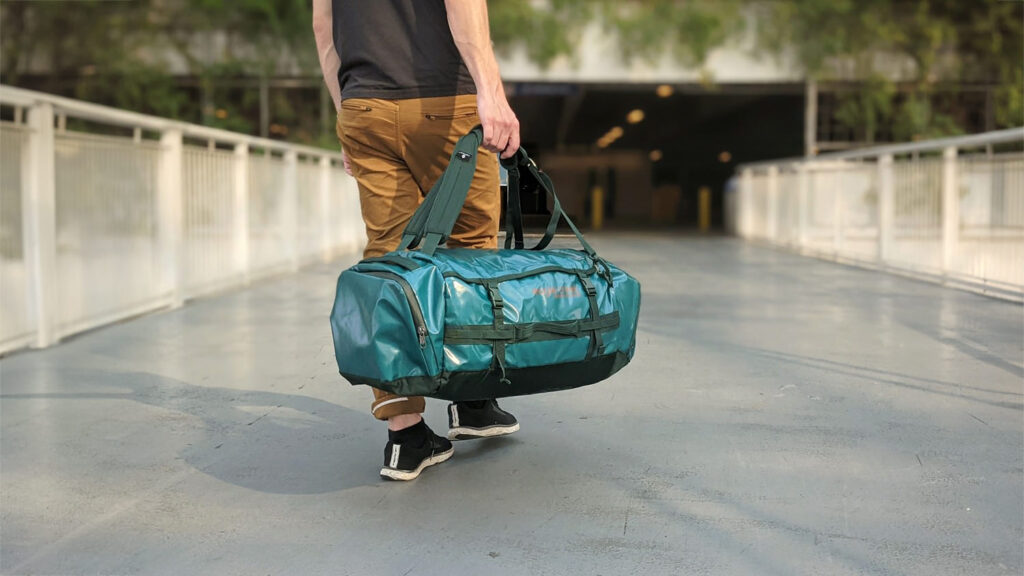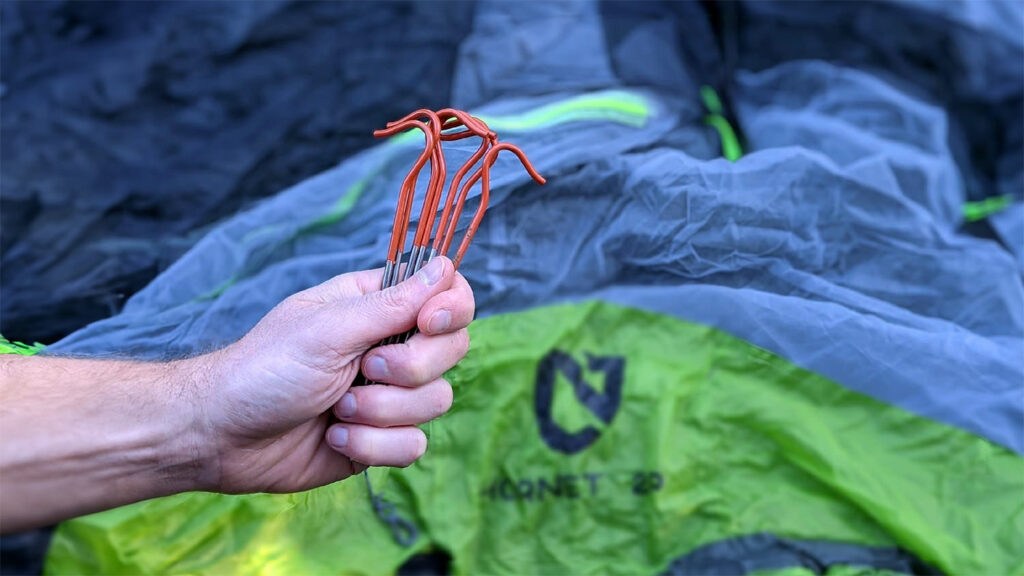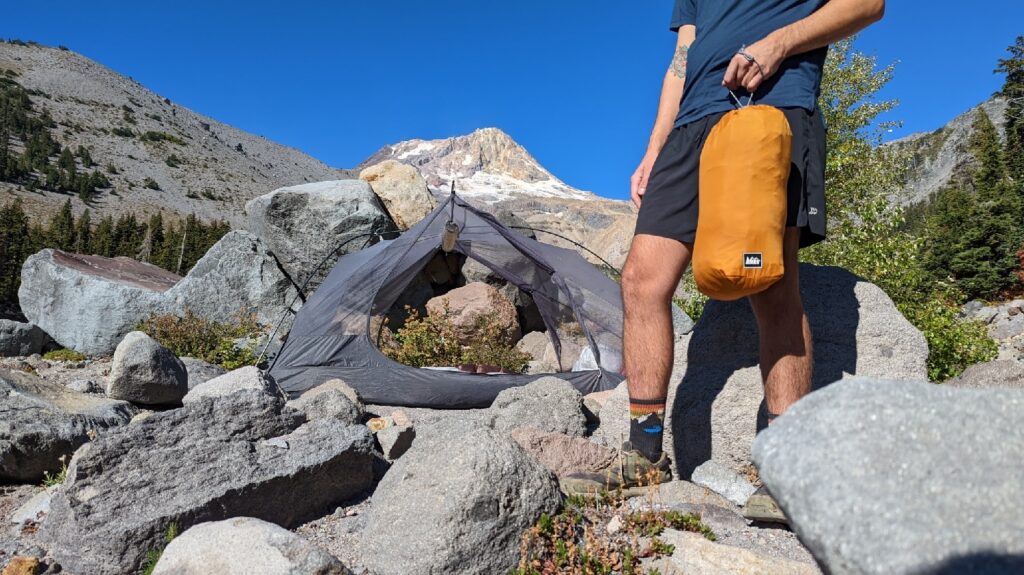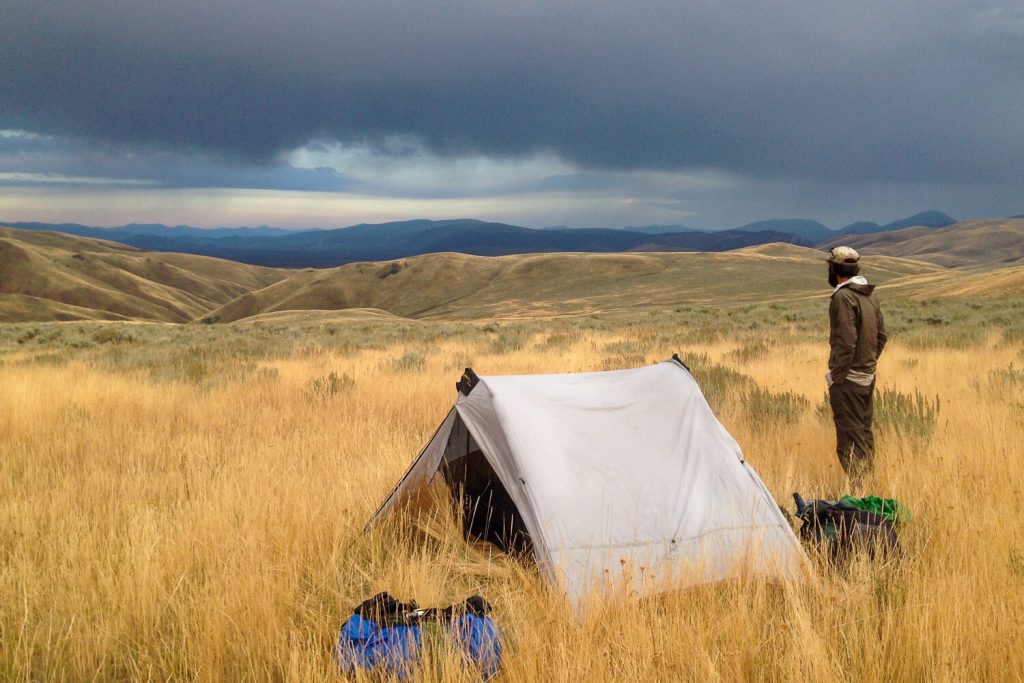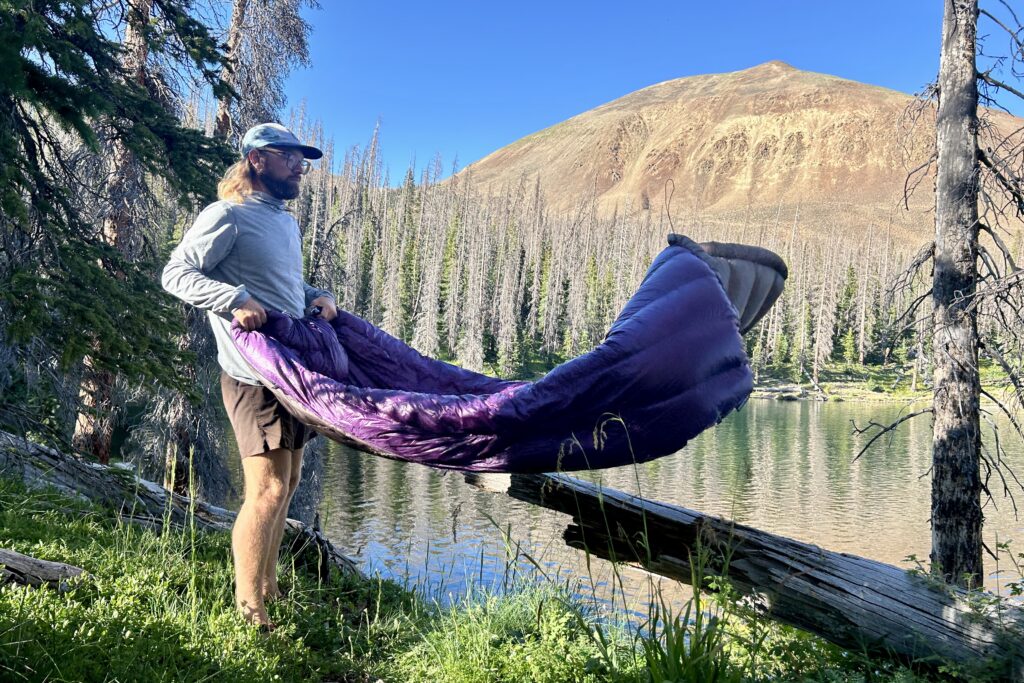
We’ve collectively spent over 1,000 nights in the backcountry testing the best backpacking sleeping bags on the market. From frigid evenings at high altitude to hot nights in the Sonoran Desert – we’ve encountered it all. We look at warmth, comfort, weight and packability, user-friendliness, and durability. Our expertise comes from hands-on experience, and we’ll guide you to the best sleeping bag option for you in our reviews below.
And for more info, check out some of our other most popular gear guides:
Quick Picks for Best Backpacking Sleeping Bags
Check out this quick list of our favorite sleeping bags, or continue scrolling to see our full list with in-depth reviews.
Best Sleeping Bag for Backpacking Overall: Feathered Friends Swallow YF 20 Men’s ($529) & Egret YF 20 Women’s ($489)
Exceptionally High-Quality & Warm Sleeping Bag: Western Mountaineering UltraLite 20 ($620)
Warm Sleeping Bag with Inclusive Sizing: REI Magma 15 ($429)
Best Winter Sleeping Bag for Backpackers: Mountain Hardwear Phantom 0 ($680)
Best Backpacking Quilt: Enlightened Equipment Revelation Quilt 20 ($345)
Best Ultralight Sleeping Bag: Sea to Summit Spark 15 Men’s ($549) & Women’s ($549)
Best Extra Wide & Comfy Backpacking Sleeping Bag: NEMO Disco 15 Endless Promise Men’s ($320) & Women’s ($320)
Best Ultralight Quilt / Sleeping Bag Hybrid: Zpacks Classic 20 ($399)
Best Budget Backpacking Sleeping Bag: Kelty Cosmic Ultra 20 Men’s ($220) & Women’s ($260)
Ridiculously Light Backpacking Quilt at a Great Price: REI Magma Trail Quilt 30 ($329)
Best Synthetic Sleeping Bag: Marmot Trestles Elite Eco 20 Men’s ($169) & Women’s ($169)
What’s New
Numerous new sleeping bags have debuted in the 2024 backpacking season, prompting us to introduce fresh picks and update our favorites.
- The Swallow YF 20 and Egret YF 20 moved into the number one spot for superior overall performance.
- The Western Mountaineering UltraLite 20 is our number two pick for its combo of warmth and light weight.
- REI released a new version of the Magma 15 so we’ve updated our review.
- The all-new Kelty Cosmic Ultra 20 / Women’s Cosmic Ultra 20 take the title of Best Budget Backpacking Sleeping Bag.
Backpacking Sleeping Bags Overall Testing Scores
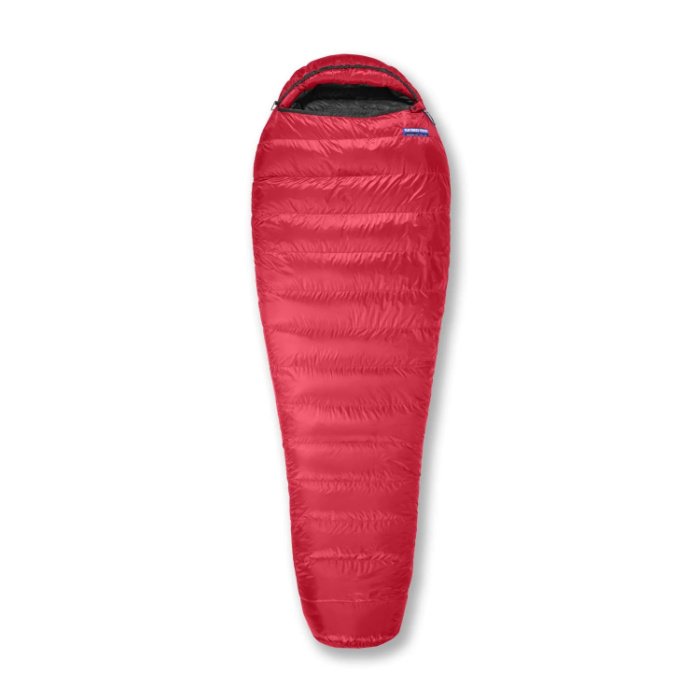
Feathered Friends Swallow YF 20 / Egret YF 20
Best Sleeping Bag for Backpacking Overall
CleverHiker Rating: 89.5/100
Price: $509 – $529
Comfort Rating: N/A
Weight: 1 lb. 12.7 oz. / 1 lb. 13 oz.
Fill Power: 900+
Fill Weight: 16.8 oz. / 17.3 oz.
Pros
- Ultralight for a mummy bag
- Highly packable
- Excellent warmth-to-weight ratio
- Large hood can accommodate a pillow
- Snag-free zipper
- RDS certified
Cons
- Expensive
The Feathered Friends Swallow YF 20 and women’s Egret YF 20 are some of the highest quality down bags for backpacking on the market. CleverHiker Senior Gear Analyst, Casey Handley, has used the Egret YF in frigid conditions – including a string of 20-degree nights in Utah, a winter campout in Nevada’s Sheep Mountain Range, and a late-season hike on Broken Top Mountain in Oregon with snow on the ground.
These models are very light, feel soft against the skin, and are filled with responsibly sourced 900+ fill-power goose down – which is about as nice as down comes. This is one of the few instances where we would actually trust a 20-degree bag to keep us warm when the temperature drops to 20 degrees (Feathered Friends doesn’t list EN temperature ratings, but we’ve found their ratings to be more conservative than most of the competition).
One of the biggest features that makes them so warm is the very generous draft tube – a down-filled tube that blocks cool air from entering through the zipper. Many premium sleeping bags include a draft tube, but the one on the Swallow and Egret is more robust than others and really locks in the warmth. Other warmth-preserving features include a draft collar around the neck and hood and a fitted but comfortable cut that eliminates dead space inside the bags.
Certainly the high price is one of the first things you’ll notice about the Swallow YF and Egret YF, but we can assure you they’re worth every penny if you’ll use them often. Ounce-counting backpackers might even prefer the Swallow UL and Egret UL which cost a bit more but provide the same reliable warmth as their YF counterparts at an even lower weight.
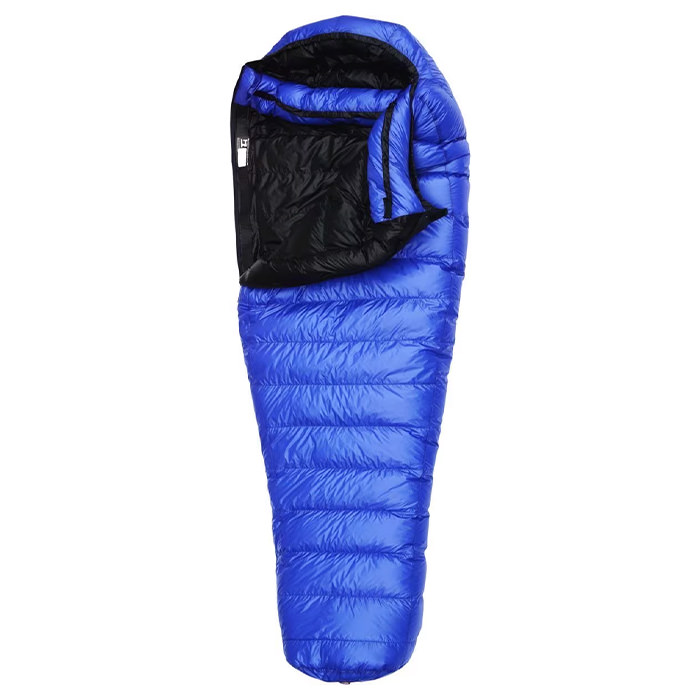
Western Mountaineering UltraLite 20
Exceptionally High-Quality & Warm Sleeping Bag
CleverHiker Rating: 88/100
Price: $620
Comfort Rating: 25°F
Weight: 1 lb. 13 oz.
Fill Power: 850+
Fill Weight: 16 oz.
Pros
- Excellent warmth-to-weight ratio
- Ultralight for a mummy bag
- Very warm
- Generous down collar & draft tube block chill well
- No-snag zipper
Cons
- Expensive
- A bit narrower than some
Every detail on the Western Moutaineering UltraLite is dialed in – it has a no-snag zipper, a 360° draft collar, and a full-length draft tube that all come together to give it one of the best warmth-to-weight ratios available. Many manufacturers name their bags with the EN lower limit – the temperature at which the average warm sleeper can sleep for eight hours without waking (not necessarily comfortably). Western Mountaineering uses a more conservative number between the EN Lower Limit and EN Comfort Rating of their bags to better reflect the temperature that most users will find more comfortable.
To put it simply, most users will find the UltraLite to be comfortable enough for a good night’s rest all the way down to 20°F. During her fall thru-hike of the Arizona Trail, Senior Gear Analyst, Casey Handley (female, warm sleeper), even experienced a couple of evenings that dipped into the teens and she stayed warm and comfortable in the UltraLite.
The UltraLite comes with a sizable price tag, but it will last for decades if treated well. Though it’s our favorite Western Mountaineering sleeping bag in terms of warmth-to-weight and comfort, some members of the CleverHiker team find it a bit narrow. If you don’t mind carrying a couple of extra ounces in favor of a roomier bag, you’ll probably love the AlpinLite 20 which is just a wider UltraLite. Cold sleepers who need some extra insulation should also give the VersaLite 10 a look. This bag sits right in between the UltraLite and AlpinLite as far as width since the design is optimized for the best balance of comfort and warmth.
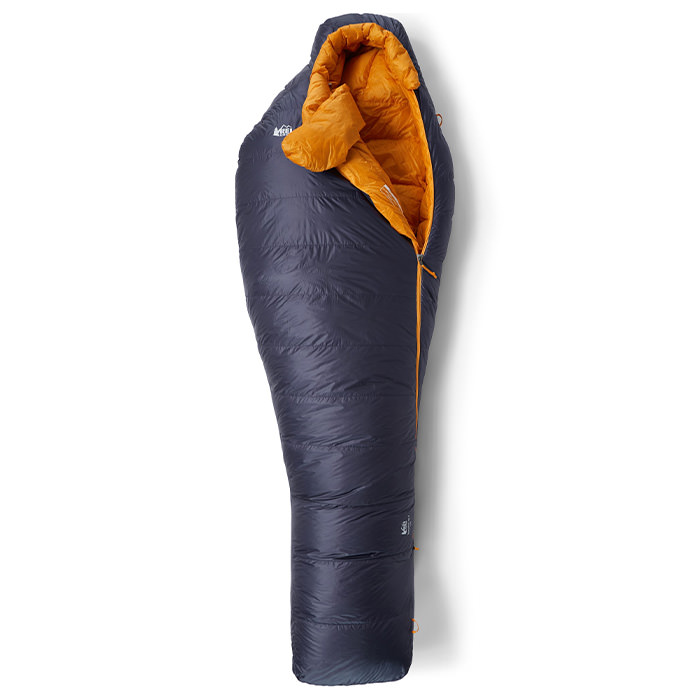
REI Magma 15
Warm Sleeping Bag with Inclusive Sizing
CleverHiker Rating: 84.3/100
Price: $429
Comfort Rating: 21°F
Weight: 2 lb. 3.6 oz.
Fill Power: 850
Fill Weight: 23.3 oz.
Pros
- Large variety of size options
- Generous draft collar blocks chill well
- No upcharge for long/wide sizes
- Good price for the warmth
- Stash pocket
- No snag zipper
Cons
- Less spacious in the hood and leg area
The REI Magma 15 has the most extensive size-run we’ve seen offered for sleeping bags, and we’re really excited about the move to provide inclusive sizing. This unisex bag is warmer than their predecessors and have a refined fit that is comfortable for a wide variety of body shapes.
The Magma 15 is comfort-rated to 21°F (as opposed to the 28°F comfort rating of the previous unisex version). A sleeping bag’s EN/ISO Comfort Rating is the temperature at which most cold sleepers will remain comfortable, so those who have a hard time staying warm should be cozy in this bag well below freezing. Warm sleepers can certainly take the Magma 15 into the teens (provided you’re using a well-insulated sleeping pad), so it’s a great winter bag for all.
Part of what makes the Magma bag so warm is its trimmed-down design. The true mummy shape is highly efficient because it eliminates the dead space your body would otherwise have to warm up. Though there’s still some room to move in the Magma, the leg girth is a bit narrower than many similar models. Some hikers may find the space a bit tight, but there are wide models available for each length option (short, medium, long) for those who need a little more wiggle room.
This backpacking sleeping bag is highly compressible for efficient packing. If you’re a cold sleeper or you’re looking for a sleeping bag that’ll excel on high alpine and winter adventures, the Magma 15 is an excellent choice.
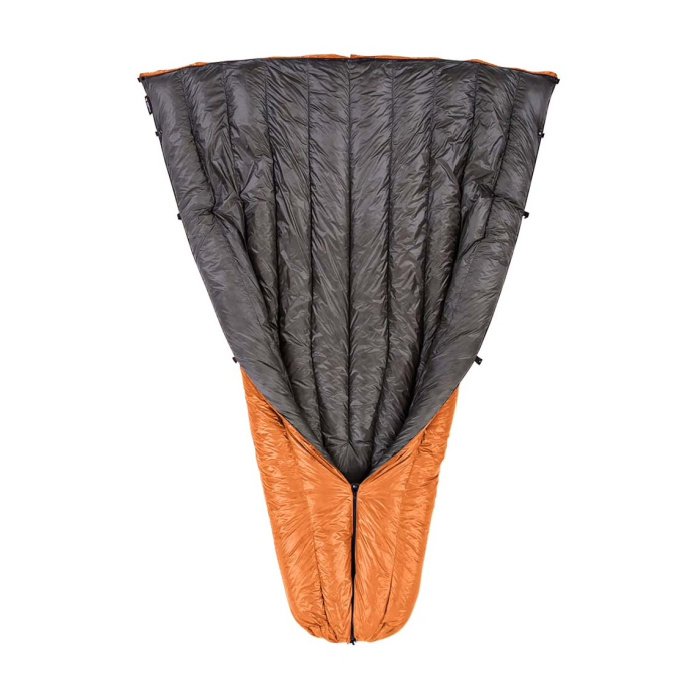
Enlightened Equipment Revelation Quilt 20
Best Backpacking Quilt Overall
CleverHiker Rating: 83/100
Price: $345
Comfort Rating: N/A
Weight: 1 lb. 6.3 oz.
Fill Power: 850
Fill Weight: 16.1 oz.
Pros
- Ultralight
- Versatile
- Affordable for the quality
- Stock & customizable options available
- Highly packable
- RDS certified
Cons
- Not warm enough for sub-freezing trips
- Long lead time for custom orders
The Enlightened Equipment Revelation is the sleep system we reach for most often when we want the benefits of an ultralight quilt over a more robust sleeping bag. Its versatile design has been a game changer on our backcountry trips – it can be cinched up tight for cold nights or opened up fully like a blanket when it’s warm out.
CleverHiker Founder, Dave Collins, has been using the Revelation as his go-to sleep sack for nearly a decade. He’s carried this quilt for over 100 nights and well over a thousand trail miles of epic adventures, such as his Wonderland Trail thru-hike and traverse through Bryce Canyon. He has a 20-degree Revelation which he loves for trips where temperatures stay above freezing and a 10-degree Revelation he packs when he expects the weather to dip into the 20s.
The excellent craftsmanship of the Revelation makes it a popular choice for thru-hikers wanting to keep weight low without sacrificing durability. As we mentioned earlier, we’ve been using ours for years and it’s still one of the best investments we’ve made in our backpacking setup.
Those wanting to save even more weight should also give the EE Enigma a look – it features a sewn footbox that makes it more heat-efficient. Several members of the CleverHiker team prefer the Revelation for its versatility, but Managing Editor – Ben Applebaum-Bauch – favors the Enigma. He used it for his CDT thru-hike, and it’s the quilt you’ll catch him rocking most of the time. Both options are great, but colder sleepers will likely benefit more from the boost in warmth provided by the Enigma.
It’s important to keep in mind that quilts don’t have a back or a hood and generally aren’t as warm as sleeping bags. Think about the conditions you typically backpack in before deciding to go with a quilt if you’ve never tried one before. If you mostly backpack in warmer summer months, the Revelation could be an excellent choice. You can always boost your warmth in the backcountry with a warm hat, puffy jacket, and an insulated sleeping pad, so quilts are still useful beyond the summer months if you pack some supplemental warmth for chilly nights.
If you don’t need your quilt right away, you can choose to custom order your Revelation with your desired color, size, and temperature rating. We bumped up a size in length and width for full coverage on chilly nights – this brought the total weight of our Revelation up to about a pound and a half. The 20°F model keeps us warm to right around freezing or just a little below, which is some pretty impressive warmth for that weight.
If you’re curious about how the Revelation compares to our other favorite quilts, check out our list of the Best Backpacking Quilts where it ranks number one.
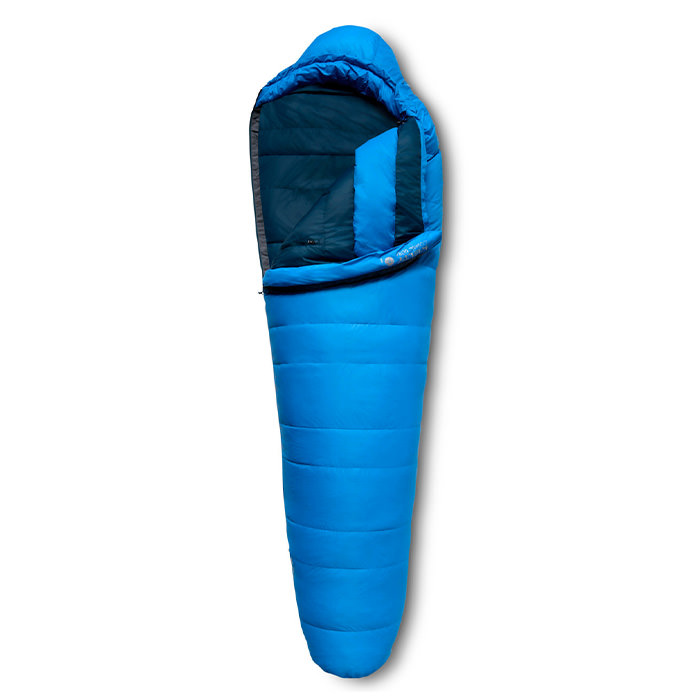
Kelty Cosmic Ultra 20 / Women’s Cosmic Ultra 20
Best Budget Backpacking Sleeping Bag
CleverHiker Rating: 77.5/100
Price: $220 – $260
Comfort Rating: 31°F / 25°F
Weight: 2 lb. 5.6 oz. / 2 lb. 14 oz.
Fill Power: 800
Fill Weight: 15.2 oz.
Pros
- Less expensive
- Above-average durability
- Stash pocket
- Draft collar & draft tube block chill well
Cons
- Heavier/bulkier than others
- Zipper can snag
- Slimmer draft tube
- Smaller hood size
This year’s Kelty Cosmic Ultra 20 (men’s / women’s) model utilizes 800-fill-power Dridown, whereas the Cosmic Down 20 model is filled with 550-fill-power down. Consequently, the Cosmic Ultra is significantly lighter and more compact than its predecessor. Dridown is treated with a water-resistant coating, reducing the likelihood of soaking through in wet conditions, and it also dries quickly if the bag does become wet.
Though the Cosmic Ultra is still among the heaviest and bulkiest sleeping bags on our list, you won’t find a better down sleeping bag at a better price. If you’re concerned about weight but really need to stay within a specific budget, we recommend investing in a lightweight sleeping pad to make up the difference.
The Cosmic Ultra is more durable than many other bags thanks to its thicker shell fabric. The outer is made with 20-denier nylon as opposed to the more common 10 or 15-denier shells used to construct the majority of the bags on this list. Kelty also includes premium features – like a stash pocket, draft collar, and draft tube – and this plush bag is plenty warm for temperatures down to freezing.

Marmot Trestles Elite Eco 20
Best Synthetic Sleeping Bag
CleverHiker Rating: 73.3/100
Price: $169
Comfort Rating: 32°F
Weight: 2 lb. 6 oz.
Fill Power: N/A
Fill Weight: 25 oz.
Pros
- Affordable
- Above-average durability
- Stash pocket
- Synthetic fill retains insulative properties when damp
- Compression sack included
Cons
- Heavier/bulkier than others
- A little tight in the leg
Synthetic sleeping bags are an awesome option for hikers on a budget and for those who aren’t down with down fill. The Marmot Trestles Elite Eco 20 has some surprisingly cool features for how little it costs, and it’s also lighter than many other synthetic options.
Though it won’t quite match up to an 850+ fill-power down bag, the Trestles packs down decently small and is pretty light despite its recycled synthetic fill. Still, it’s one of the heavier and bulkier sleeping bags on our list, so you’ll have to choose between saving weight and bulk or saving money.
One of the biggest reasons to go with a synthetic-fill sleeping bag is that it will keep you warmer than a down bag when wet and it’ll also dry out quicker. Lead tester, Casey, used the Marmot Trestles on her thru-hike of the Appalachian Trail, and the synthetic fill was a real lifesaver through the soggier sections of the Great Smoky Mountains and Virginia.
One pretty unique feature that makes the Trestles special is its blanket-fold zipper. This ¼ length zipper allows you to flip the top of the sleeping bag down – much like you would your comforter at home – when you want warmth at your feet but ventilation up top. Other features, like the internal stash pocket for keeping important items safe in freezing temperatures and the included compression sack, make the Trestles a truly great buy.
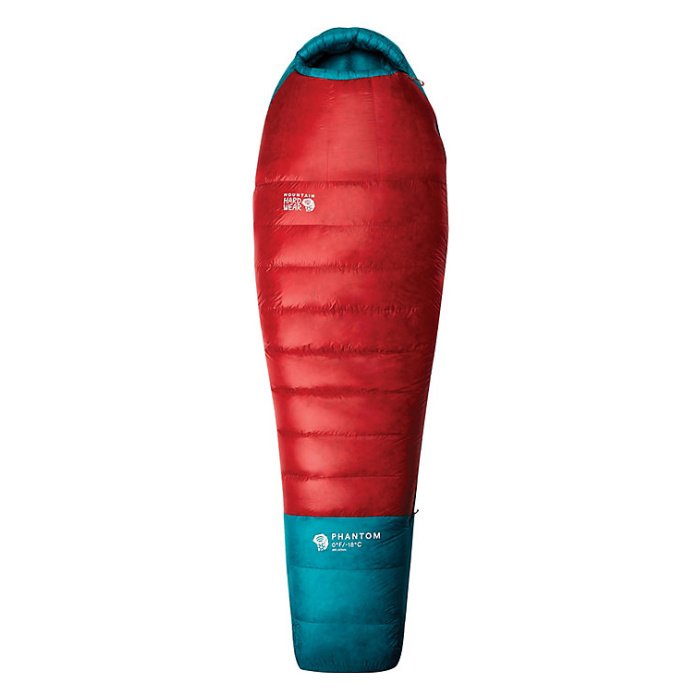
Mountain Hardwear Phantom 0
Best Winter Sleeping Bag for Backpackers
CleverHiker Rating: 84.3/100
Price: $680
Comfort Rating: 13°F
Weight: 2 lb. 10.6 oz.
Fill Power: 850
Fill Weight: 29.6 oz.
Pros
- Very warm
- Excellent warmth-to-weight ratio
- Generous down collar & draft tube block chill well
- Well-priced for a 0° bag
- No-snag zipper
- Compression sack included
- RDS certified
Cons
- Expensive
- Fit is a bit narrow
The Mountain Hardwear Phantom 0 is lighter and priced lower than a lot of the leading winter sleeping bag competition, so it’s a no-brainer for all-season adventurers and those who have a hard time staying warm at night.
Two important things to look at when deciding if a sleeping bag is going to be as warm as its temperature rating suggests are fill power and fill weight. The Phantom is stuffed with 30 ounces of 850-fp down – anything above 800-fp is generally considered very high-quality down. The Phantom also has a full-length draft tube and a wraparound draft collar that really seals in the heat on chilly nights.
It’s important to keep in mind that the Phantom’s comfort rating is 13°F, so most people probably won’t stay comfortable all the way down to 0°F, but that’s not what most people need most of the time. Hikers heading into the backcountry in sub-freezing conditions, or those that aren’t staying warm with a higher temperature bag on a decently insulated sleeping pad, will love this exceptional winter sleeping bag.
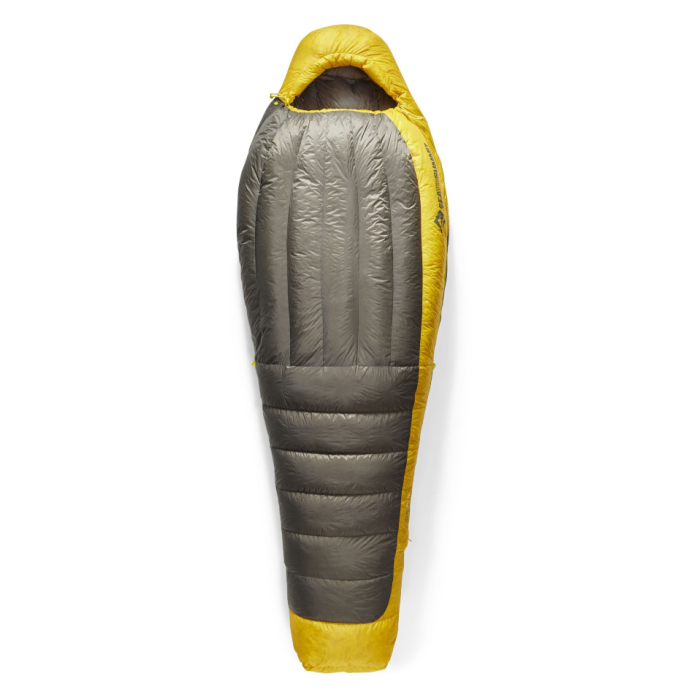
Sea to Summit Spark 15
Best Ultralight Sleeping Bag
CleverHiker Rating: 82/100
Price: $549
Comfort Rating: 29°F
Weight: 1 lb. 9.7 oz. / 2 lb. 0.8 oz.
Fill Power: 850
Fill Weight: 16.9 oz. / 24.2 oz.
Pros
- Ultralight
- Highly packable
- Excellent warmth-to-weight
- Compression sack included
- Draft collar blocks chill well
- RDS certified
Cons
- Expensive
- Thin material
- Zipper can snag
The Sea to Summit Spark 15 (men’s / women’s) are the pinnacle of mummy-style ultralight bags. These impressively lightweight sleeping bags feature draft tubes on the zippers, 360° down collars, and box baffles that make them exceptionally warm for their weight.
Baffles are sewn parts of a sleeping bag that hold feathers in place – they can be arranged in a wide variety of patterns. The Spark has vertical box baffles on the torso which prevent down from shifting away from your core where you really need the warmth. This style is especially useful for sleepers who roll over from side to side since movement can cause down displacement inside bags with continuous baffles.
The Spark is on the pricey side due to their premium construction and 850 fill goose down, but that’s also what makes them so light and packable for how warm they are. You can’t get much lighter than the Sea to Summit Spark unless you choose a quilt, but you’ll sacrifice some heat efficiency in doing so. The Spark is the best option for ultralight backpackers wanting to save every gram possible without giving up the warmth of a full mummy bag.
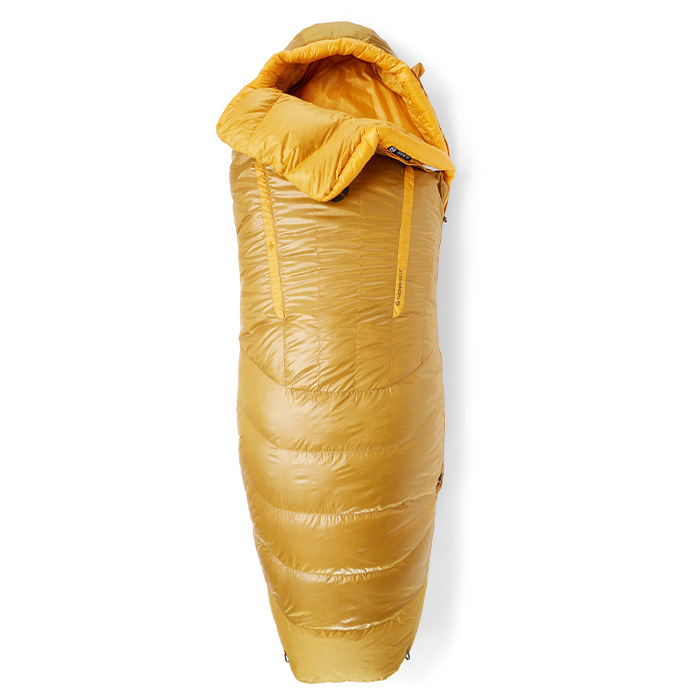
NEMO Disco 15 Endless Promise
Best Extra Wide & Comfy Backpacking Sleeping Bag
CleverHiker Rating: 79.8/100
Price: $320
Comfort Rating: 25°F
Weight: 2 lb. 11 oz.
Fill Power: 650
Fill Weight: 23 oz.
Pros
- Roomier fit than other bags
- Above-average durability
- Generous down collar & draft tube block chill well
- Waterproof footbox
- Fully recyclable design
- Pillow pocket
- Stash pocket
- Compression sack included
- RDS certified
Cons
- Heavy
- Bulky
- Not as heat efficient as some
The NEMO Disco 15 Endless Promise (men’s / women’s) has a unique shape that’s roomier than typical mummy bags, so it’s one of the comfiest options available for side sleepers. The fit also makes it a viable option for car camping where comfort tends to be a bigger priority than weight savings and technical performance.
On the flip side, roomy bags like the Disco are less heat efficient because your body has to warm up the extra space. This shouldn’t be a big deal if you’re mostly using the Disco in temperatures that are above freezing, but it’s something to consider before purchasing if extra wiggle room isn’t your main priority.
The spacious spoon shape isn’t the only thing that sets the Disco apart. This bag has several unique features, like a pocket to hold your pillow in place and NEMO’s signature “Thermo Gills” that help vent heat on warm nights.
One of the most exciting things about the newest Disco is its inclusion in NEMO’s new Endless Promise program. Recognizing the large impact that their products can have on the environment, NEMO’s Endless Promise gear is designed to be durable, easily repairable, and fully recyclable. To follow through on that promise, NEMO provides a free return label to users when their bag is ready to be recycled into something new, they’ll send it to the appropriate recycling facilities and then they’ll send you a gift card as a thanks for helping keep waste out of the landfill.
We view the Disco as more of a crossover bag than strictly a backpacking sleep sack. But its reasonable price and roomy comfort make it a good investment for those looking for a single bag that’s practical for both car camping and backpacking.
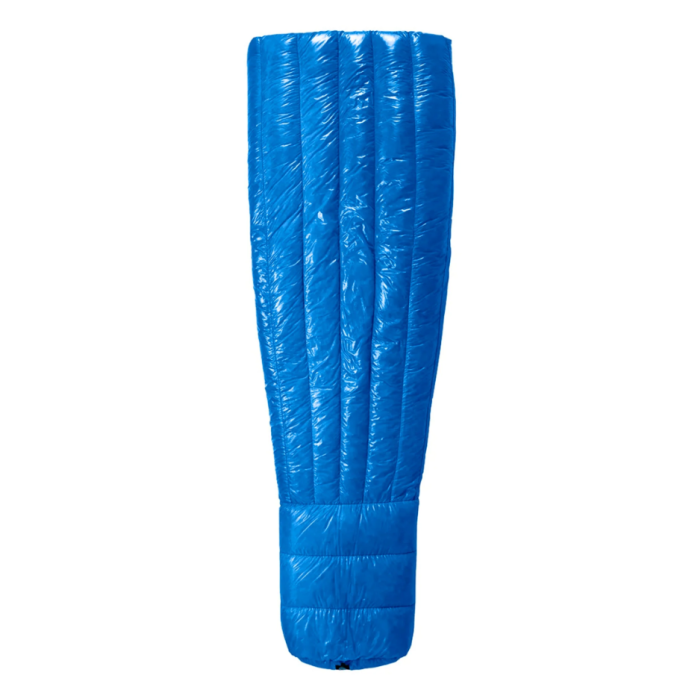
Zpacks Classic 20
Best Ultralight Quilt / Sleeping Bag Hybrid
CleverHiker Rating: 79.5/100
Price: $459
Comfort Rating: N/A
Weight: 1 lb. 2.8 oz.
Fill Power: 900
Fill Weight: 12.7 oz.
Pros
- Ultralight
- Excellent warmth-to-weight ratio
- Highly packable
- Overstuffed baffles prevent cold spots
- RDS certified
Cons
- Expensive
- Not warm enough for sub-freezing trips
- No hood
Zpacks is a leader in ultralight gear and the Classic Sleeping Bag is one of the most impressive pieces from its lineup. This sleep sack combines the best elements of a quilt and a sleeping bag to create a light but luxuriously warm hybrid.
The Classic omits a hood and is designed with an opening at the back. On warm nights, the zipper can be left open to use the Classic like a backless quilt.
Similar to ultralight sleeping bags, the Classic has a ¾ length zipper and a fully-sewn footbox to maximize heat retention. The vertical baffles on the torso prevent the down-fill from shifting to the sides away from where you really need it.
The Classic is a common pick for thru-hikers and ultralight backpackers covering long distances. CleverHiker Senior Gear Analyst, Casey, has taken the Classic on her thru-hikes of the John Muir Trail and Colorado Trail – as well as several smaller trips. This featherlight bag is still going strong after over 1,000 miles of backcountry nights.
There’s no better choice than the Zpacks Classic Sleeping Bag if saving weight is your top priority.
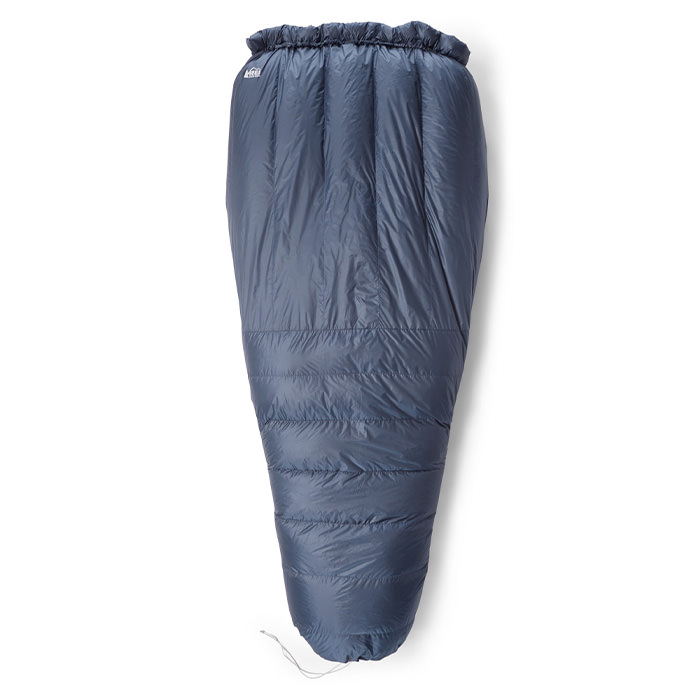
REI Magma 30 Down Trail Quilt
Ridiculously Light Quilt at a Great Price
CleverHiker Rating: 77.3/100
Price: $329
Comfort Rating: N/A
Weight: 1 lb. 4.3 oz.
Fill Power: 850
Fill Weight: 11.6 oz.
Pros
- Ultralight
- Well-priced for the quality
- Highly packable
- Suitable in warm weather
- RDS certified
Cons
- Not warm enough for sub-freezing trips
The REI Magma Trail Quilt 30 is one of our go-to sleep sacks for trips where nighttime temperatures stay above freezing. CleverHiker Founder, Dave Collins, has really put this one through the wringer on backpacking adventures through the Wind River Range, Enchantment Lakes, and the Goat Rocks Wilderness to name a few. He loves it for its tiny packed size, ridiculously low weight, and good coverage.
The newest version of the Magma Quilt is upgraded with over an ounce of extra down fill making it warmer than before. We still wouldn’t take it all the way down to 30°F, but warm-sleepers should be good to right around freezing. Cold sleepers will likely find the Magma Quilt more comfortable at 40°F and above.
The latest iteration of the Magma Trail Quilt has a zippered footbox with a drawcord at the end, which means it can be opened up fully like a blanket on warmer nights. Or, if the temps dip, zip the footbox and cinch the collar to seal in heat on chilly nights.
Often the lighter the sleeping bag/quilt the more it’s going to cost. But the Magma is competitively priced for the specs so it’s tough to beat for hikers who do most of their backpacking in warm summer months. The pared-down design will keep your summer base weight as low as possible, and this quilt compresses down absurdly small to leave room in your pack for other luxuries.
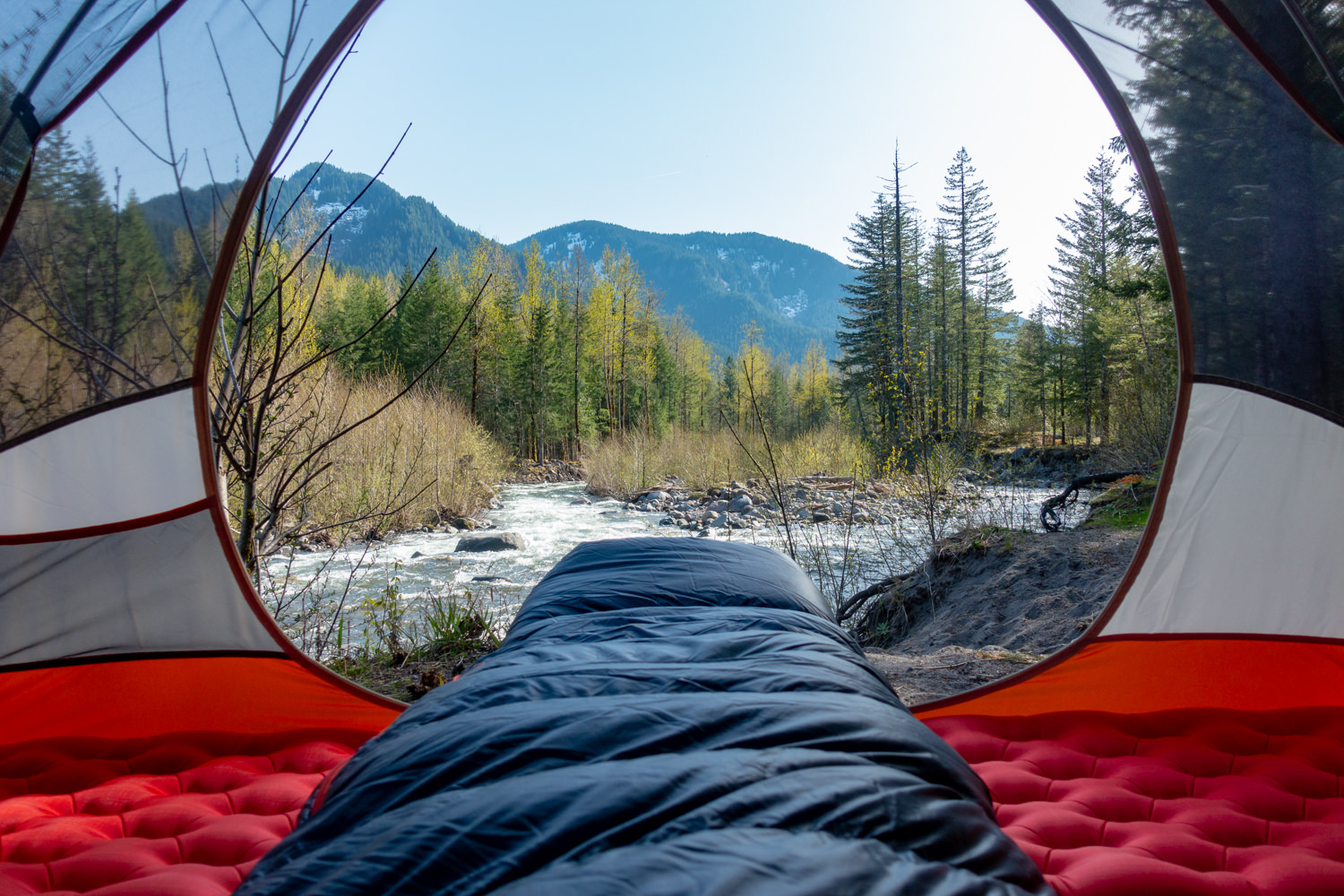
Product Comparison Table
| oSort | Product | Price | Comfort Rating | Weight | Fill Power | Fill Weight | Warmth | Comfort | Weight & Packability | Features | 0 |
Feathered Friends Swallow YF 20 / Egret YF 20 View Swallow YF 20 View Egret YF 20 |
$509 – $529 | N/A | 1 lb. 12.7 oz. / 1 lb. 13 oz. | 900+ | 16.8 oz. / 17.3 oz. | 9.5 | 9 | 8.5 | 8 | 1 |
Western Mountaineering UltraLite 20 View at Amazon View at Backcountry |
$620 | 25°F | 1 lb. 13 oz. | 850+ | 16 oz. | 9.5 | 8.5 | 8.5 | 8 | 2 |
REI Magma 15 View at REI |
$429 | 21°F | 2 lb. 3.6 oz. | 850 | 23.3 oz. | 9 | 8.5 | 7.5 | 8.5 | 3 |
Enlightened Equipment Revelation Quilt 20 View Stock Revelation |
$345 | N/A | 1 lb. 6.3 oz. | 850 | 16.1 oz. | 7.5 | 8 | 9.5 | 9 | 4 |
Cosmic Ultra 20 / Women’s Cosmic Ultra 20 View at Amazon View at Kelty |
$220 – $260 | 31°F / 25°F | 2 lb. 5.6 oz. / 2 lb. 14 oz. | 800 | 15.2 oz. | 8 | 8 | 7 | 8 | 5 |
Zpacks Classic 20 View at Zpacks |
$459 | N/A | 1 lb. 2.8 oz. | 900 | 12.7 oz. | 7 | 7.5 | 10 | 7 | 6 |
Sea to Summit Spark 15 View Men's View Women's |
$549 | 29°F | 1 lb. 9.7 oz. / 2 lb. 0.8 oz. | 850 | 16.9 oz. / 24.2 oz. | 8 | 8 | 9 | 7.5 | 7 |
NEMO Disco 15 Endless Promise View Men's View Women's |
$320 | 25°F | 2 lb. 11 oz. | 650 | 23 oz. | 8.5 | 9.5 | 5 | 9 | 8 |
Marmot Trestles Elite Eco 20 View Men's View Women's |
$169 | 32°F | 2 lb. 6 oz. | N/A | 25 oz. | 8 | 7 | 6.5 | 8 | 9 |
REI Magma 30 Down Trail Quilt View at REI |
$329 | N/A | 1 lb. 4.3 oz. | 850 | 11.6 oz. | 9 | 8.5 | 7.5 | 8.5 | 10 |
Mountain Hardwear Phantom 0 View at REI View at Mountain Hardwear |
$680 | 13°F | 2 lb. 10.6 oz. | 850 | 29.6 oz. | 10 | 9 | 5.5 | 8.5 |
|---|

How We Tested & Methodology
We tested the warmth, packability, comfort, features, and durability of more than 35 models to create this list of the best backpacking sleeping bags. Most of the models on this list have traveled hundreds – or even thousands – of miles with us on thru-hikes. Here’s what we look for and the guidelines we use to rank the bags:
WARMTH
We spent at least five nights in each sleeping bag (but typically many, many more) in various temperature conditions to find their comfort range for the average user with a reasonably insulated sleeping pad (R-value between 3.5 and 5). Our in-field testing reveals which bags are prone to cold spots and which ones have the most effective baffle designs that trap in heat. We also analyzed fill weight against the fill power to rank the warmth-to-weight ratio of each bag. From winter nights below freezing along Oregon’s White River to spicy spring evenings in the low desert of Arizona, we assessed the practical upper and lower limits of each bag.
WEIGHT & PACKABILITY
To evaluate the packability of the sleeping bags in our testing pool, we cinched each one into a compression sack and compared the sizes side-by-side. All of the gear we review also takes a turn on our scale to verify the claimed weight.
COMFORT
For this parameter, we looked at the hip, foot, and shoulder girth of each bag; the fit of the hood; the softness of the shell material; and the adjustment points. Using these criteria, we established which type of sleeper would find each bag most comfortable (e.g. bags that are wider at the shoulders are generally more comfortable for our testers who side-sleep, our testers who sleep cold are more comfortable in sleeping bags with a snug fit and hoods that cinched tight, etc.)
FEATURES
We scrutinize every detail of the sleeping bags we test – both on trail and off. We first examine the ease of operation of the zippers to make sure they glide smoothly and don’t snag on the shell fabric. We test cinch cords by adjusting them while inside the bag, looking for ease of reach and checking that cord locks hold securely once tightened. We evaluate internal and external pockets for their utility in keeping small, essential items, like a phone or water filter, safe from freezing temperatures, which is vital in cold weather camping. And, we consider the overall design and placement of these features so they enhance the user experience without adding unnecessary bulk or weight.
Why Trust CleverHiker
With over 2,000 nights in a sleeping bag, the CleverHiker team has tons of experience snoozing in the wild. Casey Handley, Gear Analyst and lead tester, brings over ten years of experience hiking the length of the Appalachian Trail, Colorado Trail, and Arizona Trail, where she’s tested and evaluated a wide range of sleeping bags to identify the best options for every use case. With a background in gear sales and nearly a decade of in-depth gear reviews, Casey’s rigorous standards ensure that only the highest quality sleeping bags make it into our guide. Her expertise and firsthand knowledge of the demands of long-distance hiking make her recommendations trustworthy and reliable for backpackers of all levels.
Analysis & Results
In this section, we peel back the layers to reveal the top-performing sleeping bags when it comes to warmth, weight and packability, comfort, and features.
VALUE
We focus on performance first, but we are always on the lookout for high-value options – those with strong performance relative to their cost. We have great budget options and spendier all-stars.
The best bang for your buck on our list is the NEMO Disco 15 because it combines an impressively low price and an innovative design, with plenty of room for side sleepers who toss and turn when they sleep. A close second is the Enlightened Equipment Revelation Quilt 20, which stands out for its exceptional value due to its customizable design, high-quality materials, and excellent warmth-to-weight ratio, making it ideal for backpackers seeking versatility and lightweight performance. And, one of our other top picks for its ultralight design and exceptional warmth-to-weight ratio, the Zpacks Classic 20 is a minimalist and durable option that will last for years of backcountry adventures. All three models prioritize lightweight construction and high-quality materials like down insulation for superior warmth-to-weight ratios, water-resistant treatments, and efficient heat management.
WARMTH
Our top picks for warmth are the Mountain Hardwear Phantom 0, Feathered Friends Swallow YF 20, Western Mountaineering UltraLite 20, and the REI Magma 15. This sleeping bag provides exceptional warmth through high-quality down insulation and carefully engineered design. The Mountain Hardwear Phantom 0 leads the pack with an outstanding warmth-to-weight ratio that utilizes 800-fill insulation, massive draft tubes, and excellent hood cinches to keep the warmth in.
The Feathered Friends Swallow YF 20 is a close second, boasting 900+ fill power goose down and prioritizes thermal efficiency without compromising on weight. The Western Mountaineering UltraLite 20 stands out for its lightweight yet lofty construction, maintaining warmth through continuous baffles and a snug fit. Similarly, the REI Magma 15/30 offers versatile warmth with 850-fill power down and strategic insulation features like draft collars and well-insulated hoods. These bags are meticulously crafted to minimize heat loss thanks to draft tubes and collars, offering reliable warmth in diverse outdoor conditions.
WEIGHT & PACKABILITY
The Zpacks Classic 20, Enlightened Equipment Revelation Quilt 20, REI Magma Trail Quilt 30, and Sea to Summit Spark 15 lead the pack for their incredibly low weights and represent the pinnacle of packability. Each model stands out for its high-quality, lightweight materials, premium down insulation, and ultralight shell fabrics like Pertex Quantum or ripstop nylon.
Because these materials are so lightweight, these bags offer industry-leading warmth-to-weight ratios, making them perfect for minimalist backpackers and thru-hikers trying to keep pack weight down without compromising on warmth or comfort.
The Zpacks Classic 20 utilizes ultra-premium 900-fill power goose down and a lightweight Pertex Quantum fabric. We love the Enlightened Equipment Revelation Quilt 20 and the REI Magma Trail Quilt 30 for their versatile quilt design, durable exterior fabric, and water-resistant down to optimize thermal efficiency and reduce overall weight. And, the Sea to Summit Spark 15 excels with its feathery light 850-fill power down and vertical baffles to prioritize a compact, lightweight profile.
COMFORT
You won’t find comfier sleeping bags for backpacking than the Mountain Hardwear Phantom 0, Feathered Friends Swallow YF 20, and NEMO Disco 15 Endless Promise. These bags set the standard for staying cozy in the backcountry with their thoughtful designs and top-quality materials. These bags all offer plenty of room for unrestricted movement while you sleep, soft and skin-friendly fabrics, and excellent warmth and ventilation options that will keep you comfortable during long nights in the backcountry.
The Phantom 0 is our top pick for comfort thanks to its plush loft and excellent 0°F warmth rating, offering a real sanctuary for very cold conditions. Feathered Friends’ Swallow YF 20 stands out with its meticulously crafted down fill and ergonomic shaping, which makes for superior warmth retention and comfort without excess weight. And, the NEMO Disco 15 features its unique spoon shape, with generous extra space around the knees and elbows – perfect for folks who move in the night and side sleepers seeking comfort and warmth. And, their lightweight, packable designs make them comfortable and easy to carry all day while hiking.
FEATURES
The most convenient, user-friendly, and feature-forward sleeping bags on our list are the Mountain Hardwear Phantom 0, Enlightened Equipment Revelation Quilt 20, and NEMO Disco 15 Endless Promise. Each of these models offers innovative features that cater to diverse camping needs with excellent details to get a great night of sleep.
The Phantom 0 stands out for its mindful features like glow-in-the-dark, two-way reflective zipper pulls for easy access at night, and a contoured footbox for improved comfort and warmth no matter what position you sleep in. The Enlightened Equipment Revelation Quilt 20 offers a versatile pad attachment system to keep the quilt locked and drafts out, plus a full-length zipper with a shock cord closure at the footbox for a customizable ventilation and fit. And, the NEMO Disco 15 Endless Promise stands out for its massive oversized draft collar to seal in warmth, but also includes zippered vents on the torso to dump heat – or dial in warmth. All three models prioritize adaptability with features designed to enhance the sleeping experience in wind, rain, and snow.
How to Choose a Backpacking Sleeping Bag
TEMPERATURE RATINGS FOR BACKPACKING SLEEPING BAGS
Sleeping bags don’t create warmth, your body does. Your sleeping bag keeps you warm by trapping body heat in an enclosed space. Sleeping bags with more insulation trap heat better, so they’re warmer. Sleeping bags with lots of interior space are less efficient because they create a larger area for your body to warm up.
Your sleeping bag will be one of the four heaviest items in your backpack (tent, backpack, sleeping bag, sleeping pad), so it’s critical to strike a good balance between warmth and weight. Ideally, you’d own 2-3 sleeping bags for different seasons (but that’s expensive!). Most backpackers start out by choosing one bag that will keep them warm at the lowest temperatures they plan to hike in.
Many hikers opt for a sleeping bag with a lower limit in the 20s because that’ll be versatile enough for use in most seasons – from high elevation summer trips to chilly shoulder seasons. If you know you’ll do most of your hiking in warmer summer months, a sleeping bag rated down to 30 will likely work just fine and will save some weight and bulk in your pack.
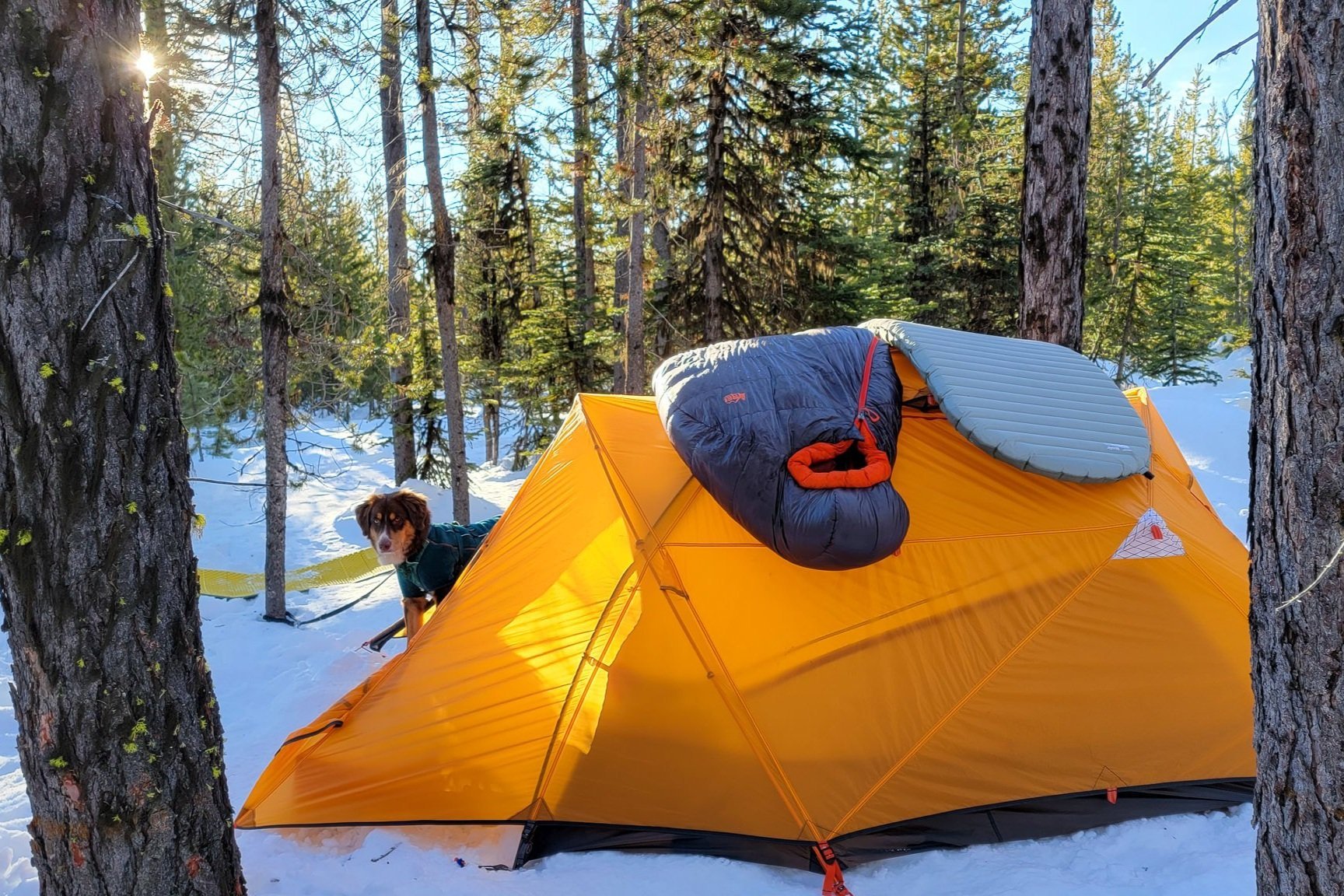
Temperature Rating Systems
European Norm (EN) and ISO are standardized temperature rating systems that keep ratings consistent across the industry. The number listed with most backpacking sleeping bags (example: Magma 15) is the EN Lower Limit which is usually 10-15 degrees lower than the EN Comfort Rating. We find that the EN Comfort Rating gives a much more realistic idea of how a bag will perform. If no comfort rating is listed, we usually estimate an extra 10-15° to the lower limit for sleeping bags and 20-25° for quilts.
Choosing the right temperature rating isn’t an exact science. Many factors contribute to warmth, like sleeping pad insulation, clothing, hydration, nutrition, and altitude. For this list, we chose sleeping bags with temperature ratings that we felt would be a good fit for most 3-season trips. Most of the backpacking sleeping bags on this list will keep the average user comfortable when temperatures dip to freezing or a few degrees below. If you know you’re a hot or cold sleeper, you’ll want to adjust your temperature rating choice accordingly.
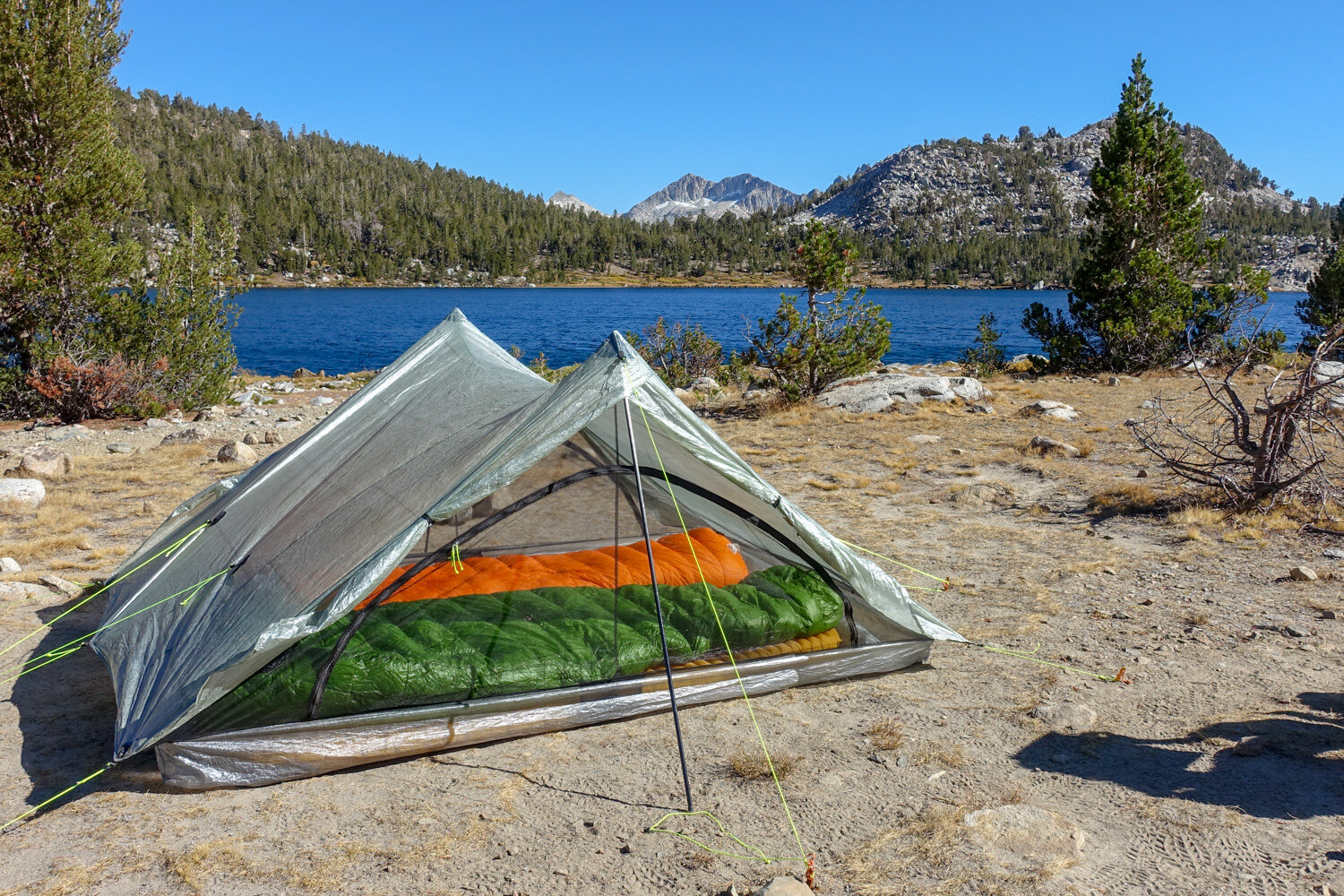
INSULATION TYPES FOR BACKPACKING SLEEPING BAGS
Down
Down insulation is more expensive but has a better warmth-to-weight ratio and packs down smaller. Down sleeping bags also last longer than synthetic bags if taken care of properly. We prefer the weight savings and packability of down bags so they make up the majority of our recommendations.

Synthetic
Though synthetic sleeping bags are often heavier and bulkier than down bags, they tend to cost less and retain heat better when wet. However, it’s important to remember that no backpacking sleeping bag will be comfortable when wet. If you end up having to spend the night in a wet sleeping bag, you’re probably going to be miserable any way you slice it. We recommend packing your sleeping bag in a waterproof stuff sack to keep it from getting wet while backpacking.

Down Fill Power & Fill Weight
The fill power (fp) of a down sleeping bag measures the quality of the down insulation it’s filled with. Higher fill power down weighs less and has more loft – but also compresses more when packed – than lower fill power down. As you might imagine, higher fill power down is also more expensive. In general, 800 fill power and up is considered high-quality down. Anything lower than that will be more cost effective, but won’t have as good warmth-to-weight.
Fill weight is the amount of down (regardless of fill power) in a sleeping bag. A higher fill weight typically translates to a warmer bag, all else equal.
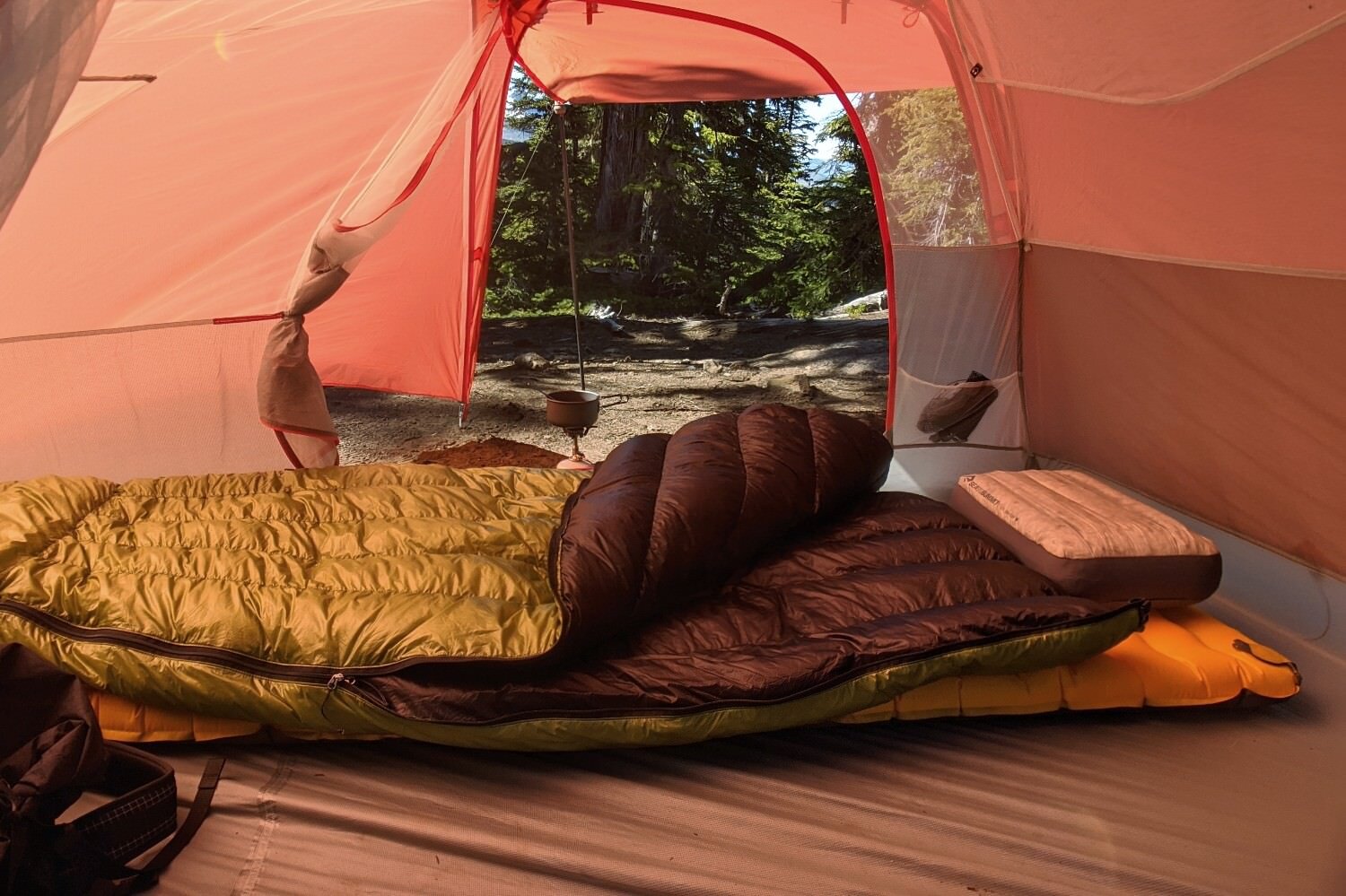
BACKPACKING SLEEP SYSTEMS – MUMMY BAGS VS. QUILTS
Mummy sleeping bags are better in cold conditions because they conform more closely to the body, reducing the amount of dead space. Quilts provide a better warmth-to-weight ratio compared to sleeping bags. They achieve this by cutting out the material and insulation that’s normally compressed under your body in a mummy bag. If a quilt sounds more like your style, you’ll love our Best Backpacking Quilts guide.
We usually prefer the flexibility, weight, and comfort of quilts when nighttime temperatures are above freezing (32°F) and mummy bags when temperatures dip below freezing.
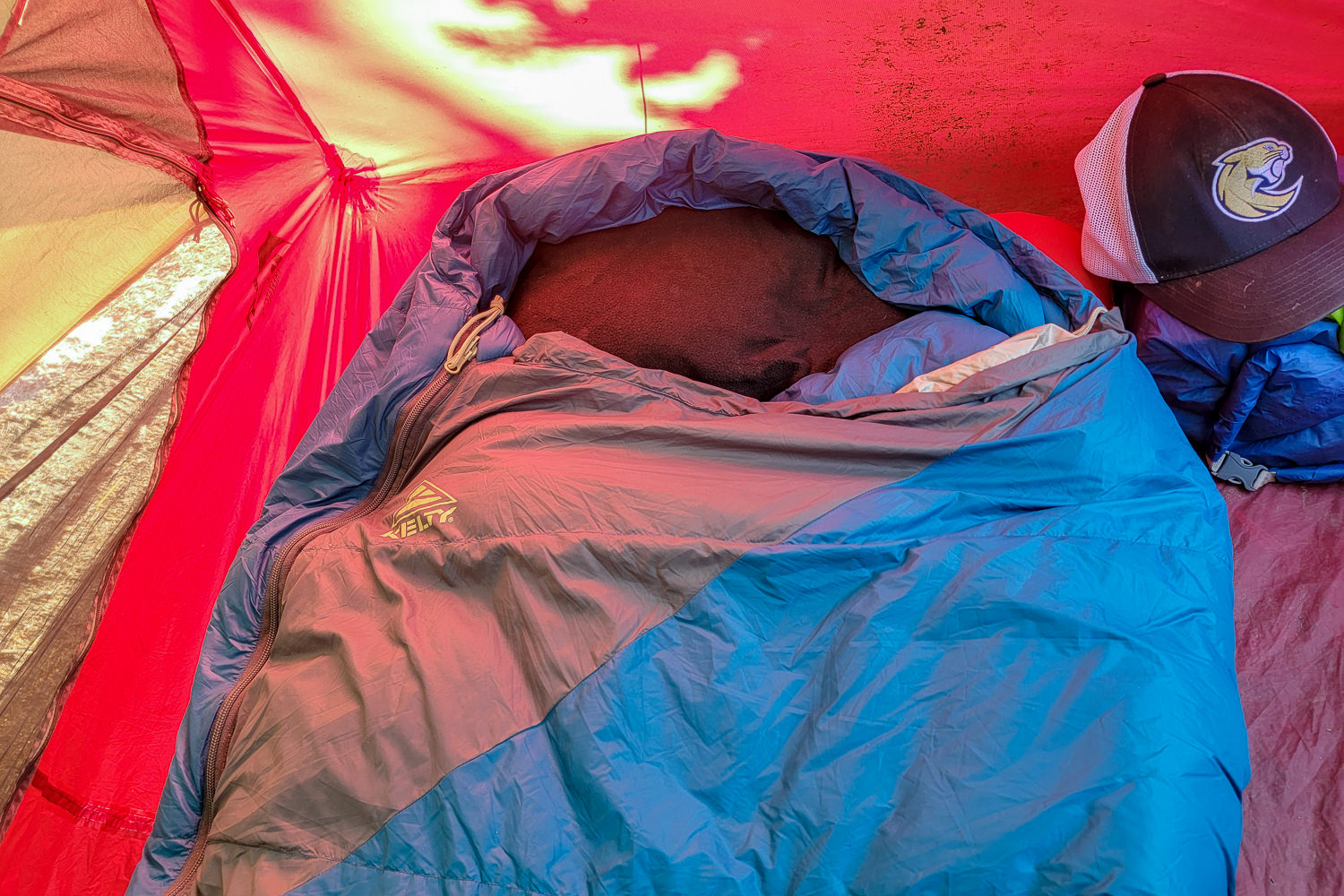
BACKPACKING SLEEPING BAG LENGTH & WIDTH
Check with the manufacturer to find the correct length sleeping bag to fit your height. If you’re on the edge, the longer size will usually be a better fit. With a quilt, consider bumping up one size for the ability to pull it over your head on really chilly nights. Mummy sleeping bags usually don’t have width options, so you’ll probably need to choose a different model if the cut is too slim. Most quilts come with the option of choosing a width, and we find that wider quilts are much more comfy if you side sleep or shift around at night.
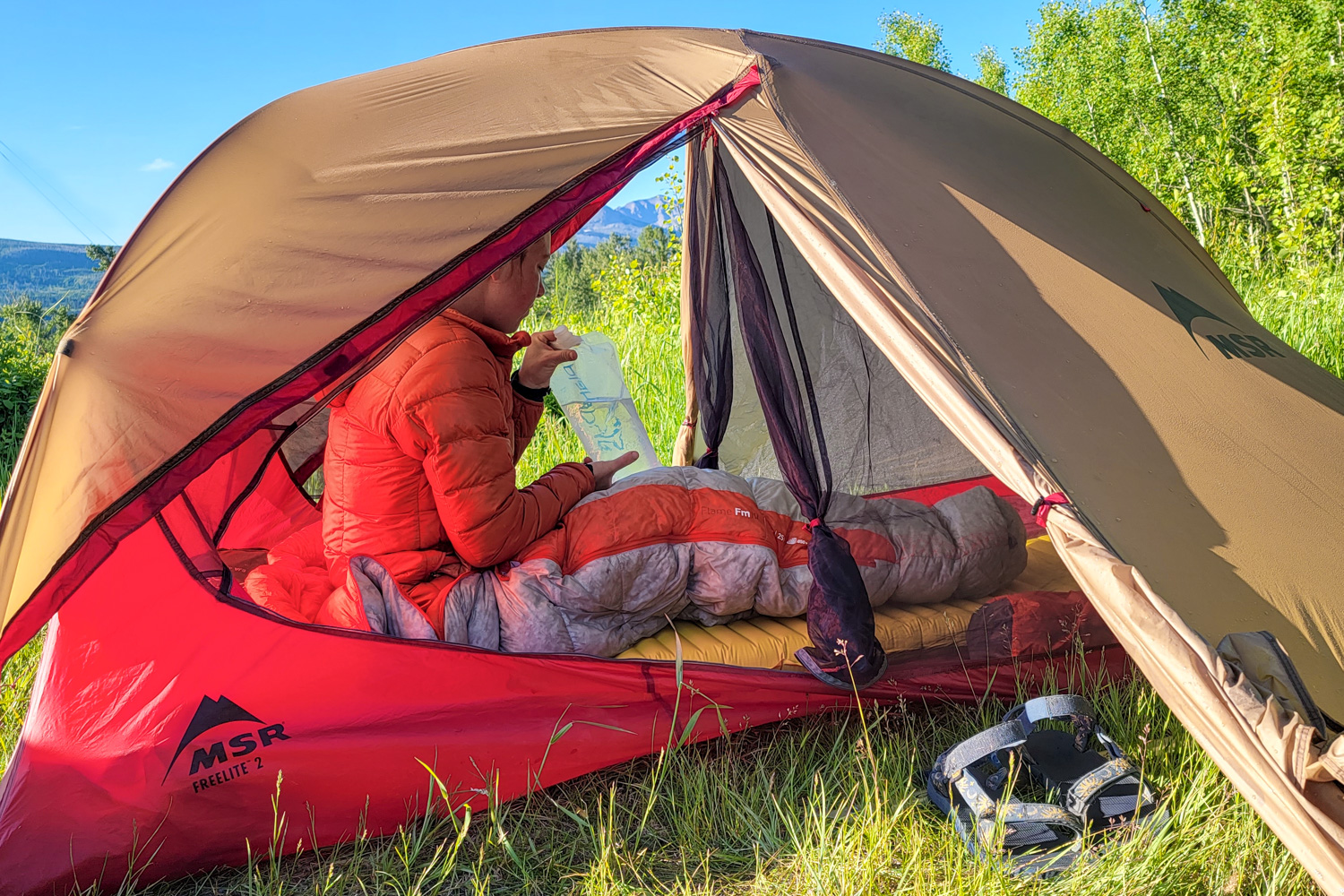
WHERE DOES DOWN COME FROM?
Down is the fluffy, small plumage found underneath the outer feather layer on waterfowl birds – mostly ducks and geese. These tiny filament fibers insulate the birds and keep them warm even in frigid conditions. Most down is a byproduct of the meat industry: 70% of it comes from China.

AVOIDING INFERIOR QUALITY & POOR ETHICS
Sometimes affordable sleeping bags are stuffed with materials other than down or contain only a small amount of down that’s blended with feathers or filler. For the best insulating value and warmth-to-weight ratio, look for backpacking sleeping bags that are made with 100% duck or goose down. If the fill power isn’t advertised, it’s likely the bag isn’t top quality and won’t compress very well. Inexpensive down bags are also sometimes made with materials that are unethically sourced. To be sure you aren’t supporting bad practices, like force feeding or live plucking, check whether a company uses traceable down or complies with the Responsible Down Standard. Companies that use good practices are generally proud of it and clearly state it for their customers to see. It’s worth paying a bit more for the peace of mind.
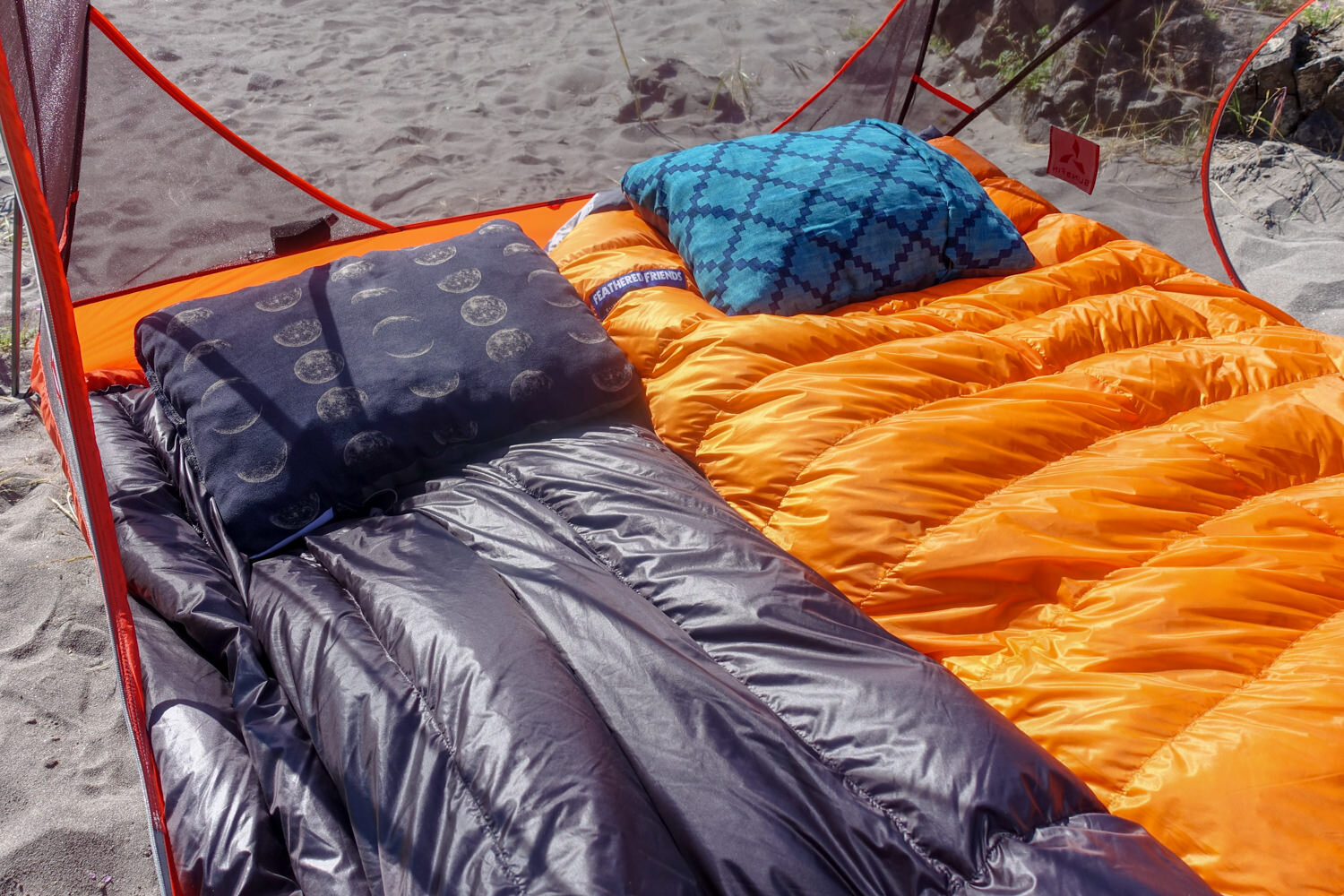
WASHING & CARING FOR YOUR BACKPACKING SLEEPING BAG
Down is a durable material, but it loses some of its efficiency when it gets oily or dirty over time. A good wash will refresh your backpacking sleeping bag and make it like new. Use a special soap like Nikwax Down Wash or a gentle non-detergent like Woolite to wash your down bag by hand or in a front-loading washing machine. After it’s washed, take your time tumble-drying it on low heat in the dryer. Adding a few clean tennis balls or dryer balls to the dryer will help break up clumps in the down and redistribute it evenly. You can also hang your down bag if you prefer to let it air dry, carefully shaking it to fluff it up several times throughout the process. Properly maintaining your down bag takes time, but you’ll likely only need to wash it once or twice per year. For more details on down care, visit How to Repair, Wash, Store, & Care For Your Sleeping Bag.

Conclusion
There are a ton of options out there when it comes to backpacking sleeping bags. From ultralight to ultra warm, we’ve tested the best of the best and we hope this guide has helped you find the perfect bag for your next adventure, whether it’s a weekend with friends or a long-distance solo adventure. Happy trails!

